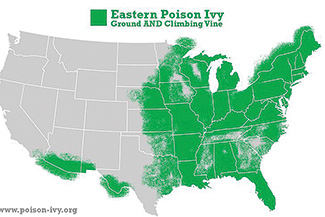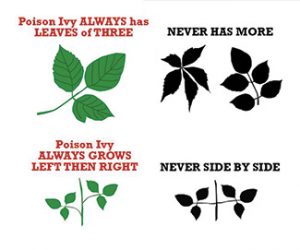 With the warm weather, many people are spending more time outdoors. This may mean an increased chance of coming in contact with poison ivy—along with its cousins, poison oak and poison sumac.
With the warm weather, many people are spending more time outdoors. This may mean an increased chance of coming in contact with poison ivy—along with its cousins, poison oak and poison sumac.
The rash from each of these plants is caused by an allergic reaction to an oily resin in the plant called urushiol. Reactions to this resin range from nonexistent to severe, depending on the individual and the extent of exposure. For most people, the rash is mild and itches for a couple of weeks before fading away.
Eastern poison ivy, which is found in Missouri, is the big bad guy. It grows on the ground, climbs, and sometimes appears as a shrub. This is the poison ivy plant that causes most of the misery since it grows on nearly every roadside, path, pond, stream and beach from the Midwest through to the East Coast.
 If you do live on the edge of wetlands, you might have poison sumac, and you might have lots of it. It has stringy berries that hang down. Sumac rashes are pretty much the same as poison ivy rashes and should be treated the same.
If you do live on the edge of wetlands, you might have poison sumac, and you might have lots of it. It has stringy berries that hang down. Sumac rashes are pretty much the same as poison ivy rashes and should be treated the same.
Here are some tips to help prepare you for poison ivy season.
- Leaves of three, let them be. The age-old advice to stay away from three-leaf plants in the woods is based in science, as poison ivy always has three leaves, usually with red stems. Poison oak and poison sumac have different leaf arrangements.
- Wash up. If you’re not sure what you touched when you stepped into a mass of green leaves, wash your hands and any other affected areas right away just to be safe. Wash your clothes, shoes and tools too—and even your pet. The oily residue sticks to everything and can still cause problems after you’ve returned home.
- Use over-the-counter remedies for minor irritation. If the rash is mild, readily available treatments such as calamine lotion, corticosteroid skin cream, Benadryl and similar products can usually offer some relief, according to the Mayo Clinic.
- More severe reactions may require medical attention. If your rash looks more serious, with large, fluid-filled blisters, swelling, fever or signs of infection, or you’re having difficulty breathing, you should see a doctor.
- Try barrier ointments. If you think you might encounter poison ivy, there are topical products on the market designed to prevent the rash by creating a barrier against urushiol.
 IF YOU’VE TOUCHED POISON IVY
IF YOU’VE TOUCHED POISON IVY
If you think you made contact with these plants, wash your skin with cool water immediately. Wipe the area with a cotton ball soaked in rubbing alcohol to help dissolve and remove the urushiol oil. You only have about 30 minutes after coming into contact with poisonous plants to minimize the symptoms of poison ivy. It’s a good idea to wash your garden tools as well, and remove and wash your clothing so you don’t spread the rash.


